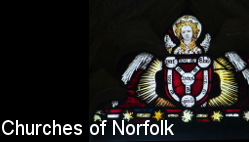
home I index I latest I glossary I introductions I e-mail I about this site
All Saints, Tattersett
Follow these journeys as they happen at Last Of England Twitter.
All Saints, Tattersett I'd not been to Tattersett church for years, and it was a delight to come this way with fellow Norfolk-explorer Cameron Self on one of the last really sunny days in the late summer of 2021. All Saints is one of East Anglia's more remote churches, reached by a half mile track across the fields. The parish includes the village of Tatterford a mile or so off, but its setting out here in the fields seems to be because it was served by a nearby priory of which a few bumps and lumps survive in the fields to the south-west. In any case, a new church was built in the centre of the village to serve the people of Tatterford in the 1860s, but the original Tattersett church remains stubbornly in use. I'd been here before in winter, but today the little church hid as a surprise behind a high field of maize, peeping its tower occasionally and then coming fully into view as we emerged into the churchyard. There are no other buildings nearby, although you can just make out the glint of some caravans towards the Kings Lynn to Fakenham road. As so often in this part of Norfolk the tower and church were built at a time when Decorated architecture was beginning to flower in the late 13th Century, and apart from a 19th century restoration and a general tidying up in the early part of the 20th Century, the only later developments externally appear to be a couple of Perpendicular windows. And yet there is something odd about the structure as we see it today. The drip line on the tower doesn't quite match the splay of the nave roof, which might be explained perhaps by an earlier roof being thatched. And the chancel is offset slightly against the east wall of the nave, and there seems to be no obvious reason for this, except perhaps that it was built exactly on the footprint of an earlier chancel while the rebuilt nave was extended slightly to the south. The windows in the south porch have been filled in, perhaps in response to the alarming splay of the porch walls outwards. The church is always
open, and you enter a notably narrow building. The
colours are muted, as if the slowness of passing time in
this lonely spot has bleached them. The font is plain but
probably of the 15th Century at which time the chancel
arch seems to have been rebuilt. The sober, narrow pews
face it in silence. The brick-outlined sedilia and
piscina in the chancel might be an early 16th Century
repair job. There are remains of a wall-painting on the
south nave wall which Pevsner suggests is the martyrdom
of St Erasmus, but it is too indistinct to tell. Simon Knott, October 2021 Follow these journeys as they happen at Last Of England Twitter. |
|
|||||||||||||||||||||||||||||||||||||||||||||||||||||||
home I index I latest I introductions I e-mail I about
this site I glossary
Norwich I ruined churches I desktop backgrounds I round tower churches
links I small
print I www.simonknott.co.uk I www.suffolkchurches.co.uk